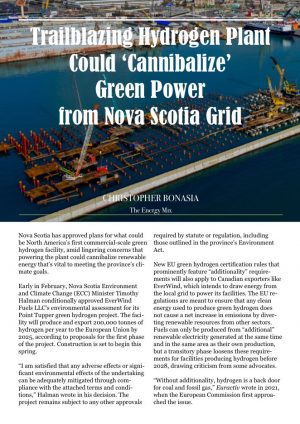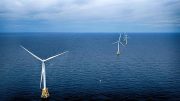 Nova Scotia has approved plans for what could be North America’s first commercial-scale green hydrogen facility, amid lingering concerns that powering the plant could cannibalize renewable energy that’s vital to meeting the province’s climate goals.
Nova Scotia has approved plans for what could be North America’s first commercial-scale green hydrogen facility, amid lingering concerns that powering the plant could cannibalize renewable energy that’s vital to meeting the province’s climate goals.
Early in February, Nova Scotia Environment and Climate Change (ECC) Minister Timothy Halman conditionally approved EverWind Fuels LLC’s environmental assessment for its Point Tupper green hydrogen project. The facility will produce and export 200,000 tonnes of hydrogen per year to the European Union by 2025, according to proposals for the first phase of the project. Construction is set to begin this spring.
“I am satisfied that any adverse effects or significant environmental effects of the undertaking can be adequately mitigated through compliance with the attached terms and conditions,” Halman wrote in his decision. The project remains subject to any other approvals required by statute or regulation, including those outlined in the province’s Environment Act.
New EU green hydrogen certification rules that prominently feature “additionality” requirements will also apply to Canadian exporters like EverWind, which intends to draw energy from the local grid to power its facilities. The EU regulations are meant to ensure that any clean energy used to produce green hydrogen does not cause a net increase in emissions by diverting renewable resources from other sectors. Fuels can only be produced from “additional” renewable electricity generated at the same time and in the same area as their own production, but a transitory phase loosens these requirements for facilities producing hydrogen before 2028, drawing criticism from some advocates.
“Without additionality, hydrogen is a back door for coal and fossil gas,” Euractiv wrote in 2021, when the European Commission first approached the issue.
EverWind’s facility is one of several emerging projects in Nova Scotia, including another green hydrogen development at Point Tupper proposed by Bear Head Energy. With the fuel take its place as an important element of Nova Scotia’s clean energy strategy, how the producers meet EU additionality requirements will have a bearing on the province’s progress toward decarbonizing its grid.
Power Sources in Question
EverWind says it will rely on power purchase agreements (PPAs) to supply energy for the plant during the project’s first phase. The company has not yet applied for an environmental assessment for the second phase, in which hydrogen production will increase to one million tonnes per year, but EverWind says it plans to have new wind farms in operation by then. In December, EverWind announced a memorandum of understanding (MOU) to lease 137,000 acres (55,440 hectares) of Crown land to install a two-gigawatt onshore wind farm in Guysborough, NS. None of that land had been set aside for new renewable energy sources for Nova Scotia’s grid, Patricia Jreige, Communications Advisor for Nova Scotia’s Department of Natural Resources and Renewables, confirmed for The Energy Mix.
But the feasibility of EverWind’s plans to source sufficient clean energy has raised questions. EverWind contested a reporting collaboration between The Mix and Halifax Examiner last fall, maintaining that it would source electricity from new wind and solar projects. The company fielded a similar inquiry by The Chronicle Herald on the feasibility of building a plant and raising an immense network of wind power within three years. “It is certainly very doable based on the windfarms we’ve got lined up to provide that,” replied CEO Trent Vichie.
“We have risked a tremendous amount of money to put Nova Scotia in a first-mover position in the market,” he added.
“Yes, we are probably moving a lot faster than we normally would, but we’re doing it with a purpose.”
But EverWind has not yet identified any specific sources of solar, wind, or other renewables for its first phase.
“Nova Scotia Power has confirmed the ability to verify/certify the origination of renewable energy sources, and is in advanced stages of sourcing specific wind renewable energy sources to power its first phase,” Lynn Hammond, the company’s vice president of corporate affairs, told The Mix. While procuring clean energy is critical to determining whether the hydrogen produced at the facility is “green,” the province does not evaluate power supply in its environmental assessment process. That’s because ECC’s mandate is to work with industries and companies to ensure impacts on the environment are minimized, but not to “have a role with any company’s business focus or scope,” a departmental spokesperson said.
“The purpose of an environmental assessment is for companies to identify and address any potential impacts of its construction and operations on the environment.”
‘Certified Green’ Hydrogen
The EU released an official legal definition of renewable hydrogen last month in a delegated act, a non-legislated measure mean to amend or update legislation quickly. The new definition will provide a basis for certifying renewable fuels of non-biological origin (RFNBOs) like hydrogen as green. While it may seem clear-cut to link a project’s operations to clean energy sources, the specifics are important to make sure that “green hydrogen production does not cannibalize existing renewable energy generation, and instead operates under newly installed capacity,” explains RenewEconomy.
The EU’s additionality requirements cover two points. A facility producing an RFNBO must use power from a clean energy installation that came into operation no more than three years prior. And the clean energy source must not have received any form of operating or investment aid, with some exceptions.
But the EU definition allows exemptions for producers that start operation before January 1, 2028, a provision that has led to different interpretations from advocates and stakeholders.
EverWind’s Hammond said EU rules “do not allow RFNBO producers to use power under PPAs with gas or coal power producers, even during the initial period in which slightly wider tests apply.” She added that RFNBO producers will need to source all their power through renewables PPAs with energy suppliers, as opposed to local wind or solar farms, when the power is transmitted through the grid.
But Brussels-based Transport & Environment says the exemption allows “projects starting before 2028 to use electricity produced from coal and gas” if the vast amount of electricity needed to produce the fuel would divert renewables from local grids. Interpretations along this line hold that slack additionality requirements would result in hydrogen projects being powered by fossil fuels. A project may be certified green—with its independent operations powered by clean energy—but adding it to a grid could result in more fossil fuels being burned.
Nova Scotia’s Decarbonization Plan
While the province is paving the way “for the production and use of green hydrogen as a clean energy source in Nova Scotia,” it is also committed to reducing overall emissions and fuel consumption under the 2021 Environmental Goals and Climate Change Reduction Act.
The act outlines statutory obligations to cut emissions by 53% below 2005 levels, phase out all coal-fired electricity generation, and supply 80% of electricity from renewable sources by 2030.
Wind power will be an important part of the province’s transition, but “there is limited land in Nova Scotia, much of which is already degraded, so we will have to be intentional about where wind power is generated,” said Brenna Walsh, energy coordinator for the Ecology Action Centre.
That means wind resources must be prioritized for use in the province’s current electricity system to replace coal and other fossil fuels, and to support the increase in grid capacity that will be needed as the province electrifies other sectors, Walsh said. She called on the province to undertake a comprehensive Crown land use planning process for wind farm construction, to avoid costs to Nova Scotia’s ecosystems and biodiversity. “If these needs can be met without the other impacts, then uses for hydrogen generation could make sense to consider.”
The role of hydrogen in Nova Scotia’s energy strategy also raised questions for Ralph Torrie, research director at Corporate Knights, who co-authored two recent reports on how the province can accelerate its phaseout of coal, reduce its greenhouse gas emissions to tackle the climate emergency, and reach net-zero by 2050. In an interview last fall, he said moving the provincial grid off fossil fuels will mean “moving very heavily into wind power.”
Rather than going all-in on hydrogen, Torrie continued, “it seems clear to me that the higher priority should be to use Nova Scotia wind to make affordable electricity for Nova Scotians. And it’s going to be a very tight passage for Nova Scotia to get to a carbon-free system.”
In a climate plan released last December, ECC notes that “having a reliable and clean source of electricity is important to help Nova Scotia respond to the demand for alternative sources of energy like green hydrogen.”
The plan calls for the province to develop a green hydrogen action plan by 2023 and set aside five gigawatts of offshore wind by 2030 to support production of the fuel, with a call for bids in 2025.
“We will all need to hold the government accountable to these goals,” said Walsh.
“As this transition occurs, working with government and other stakeholders to ensure that Nova Scotia transitions to a clean, reliable and affordable energy system will be key in our work, and is something that all Nova Scotians can push for.”
Christopher Bonasia
Originally published
by The Energy Mix
January 23, 2023





